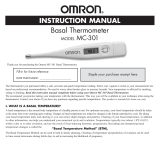Page is loading ...

One Step Ovulation Test Strip Instruction Insert
Please read all the information in this Insert before performing
the test.
The One Step Ovulation Test Strip is an in vitro diagnostic test
device intended for the rapid detection of the human Luteinzing
Hormones (LH) in urine to predict when there is a LH surge, and
in turn, when you are likely to ovulate. You can easily carry out
this test yourself.
It is intended for over-the-counter (OTC) use.
For in vitro diagnostic use only.
HOW DOES IT WORK?
The LH (Luteinizing Hormone), which is in the urine of women,
will increase dramatically in the middle of the menstrual cycle.
The LH increase triggers ovulation which is when the eggs are
released periodically from normal fertile women. WHO experts
state that LH testing is a reliable way to detect ovulation.
Ovulation will occur after 24-48 hours following a positive test.
CONTENT OF THE TEST KIT
1. One pouch containing a test strip.
2. Insert with instructions for use.
WHAT ELSE DO YOU NEED?
1. A clean, dry, plastic or glass container to collect the urine.
2. Timer or clock.
PRECAUTIONS
1. This kit is for external use only. Do not swallow.
2. Discard after first use. The test strip cannot be used more
than once.
3. Do not use the test after the expiration date printed on the foil
pouch.
4. Do not use the kit if the pouch is punctured or not well sealed.
5. Keep out of the reach of children.
STORAGE AND STABILITY
1. Store at 39°F to 86°F (4ºC to 30ºC) in the sealed pouch up to
the expiration date.
2. Keep away from direct sunlight, moisture, and heat.
3. DO NOT FREEZE.
4. You should perform the test soon after opening the pouch.
You should keep the test in a dry environment before use.
WHEN TO COLLECT URINE FOR THE TEST?
The length of the menstrual cycle is the duration from your first
menstrual bleeding day to the day before the next bleeding
begins. Determine the length of menstrual cycle before testing.
Please refer to the chart below to determine when you should
start testing. If your cycle is shorter than 21 days or longer than
38 days, consult a physician.
If you do not know your cycle length, you may begin the test 11
days after your first period since the average cycle length is 28
days. Perform 1 test each day over a 5 days period, or until the
LH surge has been detected.
Cycle
Chart
Cycle Length
Day of Cycle
to Begin Testing
21
days
day
5
22
days
day
6
23
days
day
7
24
days
day
8
25
days
day
9
26
days
day
10
27
days
day
11
28
days
day
12
29
days
day
13
30
days
day
14
31
days
day
15
32
days
day
16
33
days
day
17
34
days
day
18
35
days
day
19
36
days
day
20
37
days
day
21
38
days
day
22
39
days
day
23
40
days
day
24
HOW TO COLLECT URINE?
Urine specimens may be collected in any clean, dry, plastic or
glass container.
HOW TO DO THE TEST?
1. The test strip and urine have to be at room temperature
59-86ºF (15-30°C) for testing.
2. Remove the test strip from the sealed pouch.
3. Immerse the strip into the urine with the arrow pointing
towards the urine. Take the strip out after 3 seconds and lay the

strip flat on a clean, dry, non-absorbent surface (such as the
mouth of the urine container).
IMPORTANT: Do not allow the urine level to exceed the MAX
(marker line), otherwise the test will not perform correctly.
4. Read results in five minutes. Do not read results after more
than 5 minutes.
HOW TO READ THE RESULTS
Negative (No LH Surge) :
Only one color band appears on the control region, or the test
band appears but is lighter than the control band. This means
there is no LH surge.
Positive (LH Surge) :
If two color bands are visible, and the test band is equal to or
darker than the control band, ovulation will probably begin in the
next 24-48 hours. If trying to get pregnant, the best time to have
intercourse is after 24 but before 48 hours.
Invalid:
If no band is visible, or there is a visible band only in the test
region and not in the control region, the result is invalid. Repeat
with a new test kit.
LIMITATIONS
1. The test works only when the test procedures are precisely
followed.
2. This test may not be used as a form of birth control.
3. Consult a doctor if irregular or unusually long cycles are
experienced.
QUESTIONS &ANSWERS
1.My cycle length is outside of the range show in the table. How
will I know when to start testing? Start testing 17 days before
you expect your next period.
2.I do not know my usual cycle length. How will I know when to
start testing? If you wish to start using the test before knowing
your cycle length, we recommend you start testing on day 10.
3.What time of day should I take the test? You may test any
time of day, but you should test at approximately the same time
each day. You should not have urinated for at least 4 hours
before testing.
4.There is a big difference between the control lines of two tests.
Is this a concern? No. Variations in the color of the control band
will not affect the test result. It is only necessary to compare the
color of the test band to that of the control band on the same
test on the day the test is performed.
5.Can test results be interpreted after more than five minutes?
No. Test results must be read in 5 minutes. Though a positive
result should not change for several days, a negative result may
change to a false positive within minutes after the end of the
testing period, which would not be an accurate reading. It is
always best to read the results 5 minutes after taking the test
and then discarding the test to avoid confusion.
6.How long should I continue to perform the test? At least 5
days or until the LH surge has been detected.
7.Do alcohol or common medications affect the test? No, but
you should consult your physician if you are taking any
medication.
8.Once I see a positive result, when is the best time to have
intercourse? Ovulation is likely to occur within 24-48 hours. This
is your most fertile time. Sexual intercourse is advised within
this time frame.
9.Will the amount of liquid I drink affect the result? We suggest
that you limit your fluid intake for about two hours before you
collect your urine. Heavy intake of fluids prior to testing will
dilute the hormone in your urine.
PERFORMANCE CHARACTERISTICS
Sensitivity:
One Step Ovulation Test has a sensitivity of 25 mIU/ml.
Interfering Substances:
The following potentially interfering substances were added to
LH negative and positive specimens and no interference was
observed.
Acetaminophen, aspirin, ascorbic acid, atropine, caffeine,
glucose, hemoglobin, tetracycline, ampicillin, albumin, bilirubin.
MANUFACTURED FOR
AccuMed Biotech LLC
16727 Park Row Dr,
Houston, TX 77084
www.AccuMed.com
INDEX OF SYMBOLS
P/N: 160401
Rev. 04.2016
Consult instructions
for use
Keep away from
sunlight
In vitro diagnostic
medical device
Keep dry
Store between
4 ~ 30 ºC
Do not reuse
/



